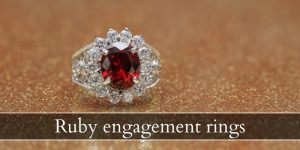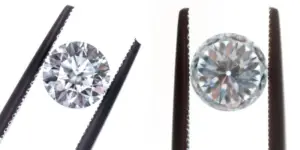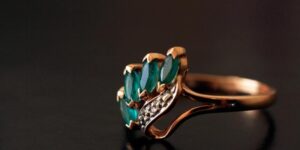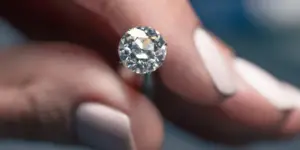Blue gemstones are possibly the most common gemstone you can find, but that doesn’t make them any less beautiful ! It simply means that if you’re looking for a blue gem you’ve got a whole lot of options to choose from. So what will it be ? You’ll have plenty of options for bight blue gems, dark blue, indigo, light blue, icy blue, opaque, and transparent gems alike.

What gemstones are blue ?
The most famous blue gems are blue sapphires, followed closely by blue topaz, aquamarine, and lapis lazuli. But there are many more blue gems including the rare blue diamond, tanzanite, iolite, and the fascinating labradorite !
We’ve compiled a list of the blue gems you’re most likely to find at a jeweler or retailer, either set in jewelry or as loose gems. In this list we discuss the color ranges, the price ranges, and the hardness of each gemstone so you know what to look for.
1. Blue diamond
Blue diamonds are a type of colored diamond that doesn’t happen very often, but when it does it produces a spectacular icy color. There aren’t as rare as pink or red diamonds, but you still won’t find them very easily. Blue diamonds fall within the fancy color diamond category, which is just a way to set apart colorful diamonds from the heavily demanded clear diamonds.
Color
Blue diamonds come in various tones of blue, from pale blue to icy blue to a medium-toned blue, Often you’ll find a grey hue in these diamonds, and sometimes they may have a slight green-yellow tint. Blue diamonds don’t excel at color, so they will usually have more of a tint than a very saturated color.
Price
Blue diamonds sell for an average of $300,000 per carat for a medium-light color and nearly flawless in clarity. You can get blue diamonds for much less when they’ve got a heavy grey tint, and when they’ve got significant inclusions or flaws within them.
Hardness
Blue diamonds score a 10/10 on the Mohs hardness scale so they are fit to wear daily, in rings and bracelets and anything that might get a hit or a bump here and there. They will still be good after several decades of wear.
2. Blue sapphire
Blue sapphires are the go-to blue gemstone, are they not ? Probably the first gem you thought of when researching what blue gems you can find. And for good reason, since blue sapphires have managed to set the standard for what a beautiful blue color looks like, and they’re not difficult to come by. Oh they’re not cheap at all, but they are very easy to find anywhere you look.
Color
Blue sapphires are usually heat treated to develop the best possible color, that cornflower indigo blue. But you can find these gems in lower saturations, even after a treatment, and sometimes they’re naturally dark blue (almost black in some cases). Sapphires may look cloudy most of the time, or have some noticeable whitish inclusions here and there.
Price
A blue sapphire with a perfect blue color sells for an average of $27,500 per carat for an eye-clean gemstone. You can easily find them for more per carat, for example of the stone is unheated. And you can find them for much less as well, if the stone is far too dark or too light. Sapphires are easy to find in very large sizes so price doesn’t go up with carats like with diamonds.
Hardness
Sapphires score a 9 on the Mohs scale of hardness, which makes them fit for daily wear in any setting or jewelry piece you like.
3. Blue spinel
Spinel is very well known as a ruby dupe, so much so that it’s often been confused for actual rubies in the past. But what about blue spinels ? Are they as impressive as their red counterparts ? It turns out blue spinels are rarer than red, and they are quite impressive, yes. These gems aren’t as well known as others on this list but you will still find them at a jeweler or retailer, both as loose stones and as ready-made jewelry.
Color
Blue spinels follow the same color range as blue sapphires, from very light blue to cornflower blue to midnight blue. You can find blue spinel with more of a sky blue color, or ones with a grey-green tint to them as well.
Price
Blue spinels are the rarest form of spinel, and they sell for an average of about $2,500 per carat for a medium-dark blue. Lighter tones like a cornflower blue are the most coveted and also the most expensive, as they can sell for as much as $4,000 per carat.
Hardness
Spinels score an 8 on the Mohs scale of hardness, which qualifies them for daily wear in nearly any sort of jewelry. They can pick up some scratches but it will take a few years for them to show enough to turn the gem cloudy.
Read also: Pink Sapphire VS Pink Diamond
4. Blue topaz
Blue topaz has got to be one of the most common blue gems on the market, to the point where people consider topaz only comes in blue. In truth topaz can be any color but blue has been in high demand even since the later 70s. You will have absolutely no trouble finding the exact shade of blue topaz you want for your jewelry.
Color
Blue topaz tends to be on the light to medium side, with more of a cobalt blue and sky blue. It ranges from pale icy blue to baby blue to sky blue to Swiss blue (almost neon blue) and all the way to London blue. London blue is a darker, inky sort of blue with a slight grey-green cast to it.
Price
Blue topaz is very affordable, averaging at $10 per carat. London blue sells for a bit more, such as $12 per carat. Topaz tends to be incredibly clear so it can benefit from a step cut as well as a brilliant cut.
Hardness
Topaz scores an 8 on the Mohs hardness scale, which makes them fit to wear daily in most types of jewelry. However given their high clarity you should keep in mind that any scratch that might come along will be very visible so a ring or a large gemstone may not be a good idea.
5. Aquamarine
Aquamarine is a type of beryl, in fact it’s emerald’s light blue cousin ! This wonderful blue gemstone has many people fascinated by its cool icy hues. This is a gemstone that is easy to find anywhere you look.
Color
Aquamarine has an incredible clarity and low color saturation, making it look like bit of very light blue ice more than anything else. You’ll find that aquamarine can be so light it can appear almost white/colorless, and even the more saturated specimens don’t have a strong color. It’s this light, crisp icy blue that captures people’s attention.
Price
Aquamarines average at $250 per carat for a light blue color and VVS clarity. Higher clarity gems and those with a better color may fetch a slightly higher price. You won’t have trouble finding aquamarine in large specimens, so if you want jewelry with a big rock you can easily find it.
Hardness
Aquamarines score an 8 on the Mohs hardness scale so they are fit to wear in most jewelry types. But, like with blue topaz, you should be mindful of the high clarity. A scratch on this high-clarity gemstone will easily be noticed. It might be best to keep aquamarines as occasional wear, or daily as earrings or pendants.
6. Paraiba tourmaline
Tourmalines come in many colors, many indeed, but their most widely known colors are black, pink, and green. But did you know there’s also blue tourmaline ? It’s rarely called blue, instead it bears the name Paraiba after the city in Brazil where this type of tourmaline was first discovered.
Color
Paraiba tourmalines have a striking turquoise color to them, and they come in fairly high saturation. They can be lighter or less saturated in color, but most of the time they will present a significant color, much like a blue topaz would.
Price
These tourmalines are incredibly rare (for a tourmaline) and as such they fetch a high price. You’ll find Paraiba tourmaline for an average of $2,500 per carat for a saturated color one. Paraiba tourmalines don’t come in very large carats so when you do find one above 1 carat it will usually have a very high price due to the rarity of such large gemstones.
Hardness
Tourmaline scores a 7-7.5 on the Mohs scale, which just barely qualifies it for daily wear in jewelry. We recommend you keep this expensive tourmaline safe in a pendant or a pair of earrings.
7. Iolite
Iolite is a very common sapphire substitute but it’s a beautiful gemstone in its own right ! This gemstone offers a different kind of blue, more of a cross between a sapphire and an amethyst, and it stands out from most blue gems because of this.
Color
Iolite ranges from a grey-indigo to a saturated indigo-purple to nearly black, so this isn’t one of the lighter color blue gemstones.
Price
Iolite is very affordable, averaging at $15 per carat form a medium saturation gemstone. It is prone to inclusions but its color is so saturated and sometimes dark then the inclusions aren’t easily noticeable.
Hardness
Iolite scores a 7-7.5 on the Mohs scale, just like tourmaline. This means you can technically wear it every day in ay sort of jewelry but it will still pick up some scratches along the way. We recommend keeping iolite as occasional wear, or in something more protective like a pair of earrings or a pendant.
8. Tanzanite
Tanzanite can be sometimes confused for iolite, but they’re quite different in terms of color. Tanzanite is beautiful on its own, with a brighter, more vivid shade of indigo that goes more towards cornflower blue than royal blue. This gem is quite easy to find and in some cases it might be classed as purple.
Color
Tanzanite comes in medium saturation shades of cornflower blue, or very vivid periwinkle. Sometimes you may find tanzanite with a darker hue, but it never gets as dark as an iolite or sapphire does.
Price
Tanzanite sells for an average of $500 per carat for a vivid color specimen and VS clarity.
Hardness
Tanzanite scores a 6.5 on the Mohs hardness scale so you may not want to wear this gem in a ring or a bracelet. It can pick up scratches faster than iolite, so it’s best to keep it in a protective setting.
9. Blue zircon
Blue zircon is not very well known, and it is often confused for cubic zirconia. Zircon is the natural version while cubic zirconia is the lab-grown version that is used to replace diamonds in costume jewelry. Of all the zircon colors available blue is the rarest and it comes in small carats.
Color
Blue zircon comes in shades very similar to blue topaz, more of a sky blue and icy blue, sometimes going as vivid as neon blue. But there is always a slight grey cast to blue zircon, which a blue topaz does not have. The darkest blue zircon is similar to a London blue topaz.
Price
Blue zircon sells for an average of $200 per carat for a vivid color gemstone. Lighter color ones or those with many inclusions may sell for less.
Hardness
Zircon is a 7 on the Mohs scale, which just barely makes it okay to wear every day. It may still scratch here and there so be sure to keep it safe.
10. Labradorite
Labradorite is not your typical gemstone, and in fact this is the first gem on this list that won’t be clear ! Labradorite has a grey-black body color with several layers of feldspar within it, giving it a blue sheen that appears to move within the stone, very similar to a ramped up moonstone.
Color
Labradorite sheen ranges from grey-blue to gold-blue to electric blue, usually contrasted by a very dark body color. These gems may also have more of a gold-pink sheen in some cases, but eh predominant sheen color is almost always blue.
Price
Labradorite is inexpensive, selling for as little as $1 per carat even for a very good color sheen. This is mostly because labradorite is not a precious gemstone and it can easily be found, so there is no short supply.
Hardness
Labradorite averages a 6 on the Mohs scale so it’s best to keep it in a protective setting such as a bezel. Only wear this gem as an occasional cocktail or statement ring, a pendant, or a pair of earrings if you won’t want to have it scratched.
11. Lapis Lazuli
Lapis lazuli is an ancient gemstone that was once used as a blue pigment. Nowadays these gems are used more for ornaments and carvings, but you can still find them in jewelry.
Color
Lapis lazuli has a striking, vivid, incredibly intense royal blue body with tiny flacks of pyrite, which make it look as if someone spilled gold shavings onto it. The effect is amazing and the contrast between the gold shimmer and the blue body has always fascinated people. The is no actual gold in it though, it’s just that pyrite appears golden in color.
Price
Just like labradorite, you’ll find that lapis lazuli is very affordable. It averages at $2 per carat and can very easily be found in large sizes so you can easily find the gem you’re looking for.
Hardness
Lapis lazuli averages a 5.5 on the Mohs scale, which is quite soft so it truly needs to be kept safe. A necklace or a pair of earrings is the best choice for this gem.
12. Turquoise
Turquoise is another gemstone with a beautiful blue color that used to be very well known. In fact turquoise is the gem after which the color was named ! This gemstone was very popular with native american indians in jewelry and cultural symbols.
Color
Turquoise has a light-blue green color, some more on the green side and some more on the blue side. Very similar to the current color of the Statue of Liberty actually, or how copper oxidizes in time. You will often find turquoise stones with grey-white flecks in them.
Price
Turquoise sells for an average of $5 per carat, and it does come in very large sizes so you can easily find the gem you need for your jewelry.
Hardness
Turquoise scores a 5.5 on the Mohs scale so it, too, should be kept as a pendant or earrings to keep it from scratching, chipping, or breaking.
What metal do blue gemstones go with ?
Blue gemstones go exceptionally well with yellow gold, but they also go great with white metals like white gold, platinum, or silver. Rose gold doesn’t seem to benefit this color of gemstones as much as others.

I’m the main author for jewelrymaterialguide.com. I started this site after we did tons of research before our wedding and noticed that there is information about rings, jewelry, and so on that is really hard to find on the internet.






